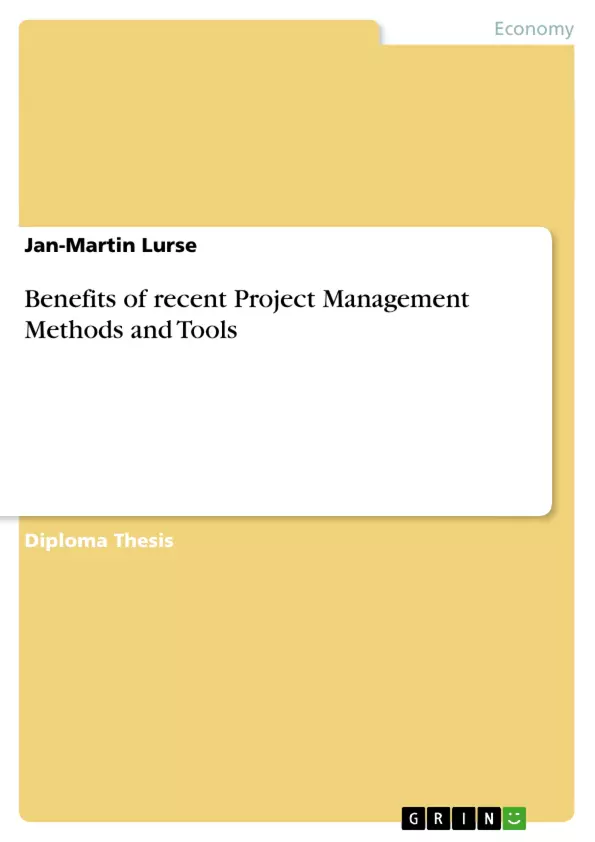A wide range of tools to support various aspects of project management are available and are being constantly improved. This research examines recently introduced methods and tools which are applied to Single and Multi-Project Management and reviews the benefits they can bring to project success and on-time performance. The work goes on to analyse whether these methods are supported by or potentially implantable into IT tools and what further benefits can be gained from software support. A survey of international industrial companies was designed and carried out to determine the requirements, benefits and criticisms of IT-based project planning as reported by people in positio ns ranging from project engineers to top managers. The data collected were evaluated qualitatively and quantitatively to determine the benefits arising from the application of IT tools and the limitations of the currently available software. Finally, proposals are made for the future development of these tools.
Inhaltsverzeichnis (Table of Contents)
- ABSTRACT.
- INDEX
- ABBREVIATIONS AND DEFINITIONS:
- TABLE OF FIGURES
- INTRODUCTION.
- THE SITUATION..
- SCOPE..
- PROCEDURE OF THIS WORK.
- RELEVANT ISSUES IN PROJECT MANAGEMENT..
- ORGANIZATION OF PROJECTS.
- Organization Structure and Size.
- Informal factors of an Organization and team building..
- Frustration.
- Optimal team size and communication
- PROJECT PLANNING: METHODS OF SCHEDULING PROJECTS AND RESOURCES.
- Types of Project Planning...
- Project structure and schedule planning methods..
- Resource allocation methods...
- PROJECT EXECUTION / STEERING METHODS AND TOOLS..
- Problem solving procedure / Customer Change Request Procedure..
- Project Team Coordination/Groupware tools...
- METHODS OF PROJECT CONTROLLING.
- Evaluating Project Progress (deadlines, costs and subject progress)
- Project Risk Assessment (risk)....
- Productivity Measurement (time) ..
- Performance Measurement (quality)....
- IMPLEMENTATION OF PLANNING PROCESSES INTO IT TOOLS
- PREVIOUS EMPIRICAL RESEARCH ON THE BENEFITS OF METHODS AND TOOLS .....
- PROJECT PORTFOLIO MANAGEMENT
- Findings of Cooper, R.G.; Edgett, S.J.; Kleinschmidt, E.J. (2001) ..
- Findings of Cooke-Davies, Terry (2002) ..
- BEST PRACTICES FOR PROJECT MANAGEMENT.
- Findings of Elonen, Suvi; Artto, Karlos, A. (2003) ..
- Findings of an analysis in Balderstone, S. J.; Mabin, V. J. (1998)...
- Findings of Diallo, Amadou; Thuillier, Denis (2004) ..
- Findings of Matheson, D.; Matheson, J. (1998) ......
- Findings of Sanchez, A. M.; Perez, M. P. (2004) ..
- Findings of Shenhar et al. (2002) ..
- Findings of Ojanen, Ville (2003) ..
- PROJECT MANAGEMENT IT TOOLS..
- Findings of Kalthoff, C.; Kunz, S. (2004) ..
- Findings of Projektron Ltd....
- Findings of Ahlborn, Jan (2003) ..
- A STUDY ON DESIRED FUNCTIONALITY IN PROJECT MANAGEMENT IT TOOLS .........
- GOAL AND PROCEDURE OF THE SURVEY.
- Goal of the Survey ..
- Design of the survey ..
- Searching for and selecting suitable participants.....
- SURVEY RESEARCH IMPLICATIONS.
- Qualitative Analysis
- Quantitative Analysis ..
- SUMMARY AND CONCLUSIONS
Zielsetzung und Themenschwerpunkte (Objectives and Key Themes)
This research aims to investigate the benefits of recently introduced project management methods and tools in both single and multi-project management settings. The work explores the potential for these methods to be integrated with IT tools and assesses the additional benefits that software support can provide. A survey of international industrial companies is conducted to gather data on the requirements, benefits, and criticisms of IT-based project planning from various perspectives. The study analyzes the data qualitatively and quantitatively to determine the benefits of IT tool application and identify limitations of existing software. Finally, the research presents proposals for the future development of these tools.
- Benefits of Recent Project Management Methods and Tools
- Integration of Project Management Methods with IT Tools
- Benefits of Software Support for Project Management
- Evaluation of IT-based Project Planning in Industrial Companies
- Future Development of Project Management IT Tools
Zusammenfassung der Kapitel (Chapter Summaries)
- Introduction: This chapter provides an overview of the current situation in project management, the scope of the research, and the procedure used in this work.
- Relevant Issues in Project Management: This chapter delves into key issues in project management, including organizational structure, team building, project planning methods, project execution tools, and methods of project controlling. It explores concepts such as project planning, resource allocation, problem-solving procedures, and performance measurement.
- Implementation of Planning Processes into IT Tools: This chapter focuses on how project planning processes can be integrated into IT tools. It explores the potential benefits and challenges of implementing these processes in software.
- Previous Empirical Research on the Benefits of Methods and Tools: This chapter reviews existing empirical research on the benefits of project management methods and tools. It examines findings from various studies on project portfolio management, best practices for project management, and the use of project management IT tools.
- A Study on Desired Functionality in Project Management IT Tools: This chapter outlines the goals, design, and procedure of a survey conducted to gather insights into the desired functionality of project management IT tools. The survey aims to understand the requirements, benefits, and criticisms of IT-based project planning from the perspective of industrial companies.
Schlüsselwörter (Keywords)
This research focuses on project management methods, tools, and their integration with IT. Key areas of focus include single and multi-project management, project planning, resource allocation, project execution, project controlling, IT-based project planning, software support, and the benefits of IT tools for project success. The research also examines the requirements, benefits, and criticisms of IT tools from the perspective of industrial companies.
- Quote paper
- Jan-Martin Lurse (Author), 2004, Benefits of recent Project Management Methods and Tools, Munich, GRIN Verlag, https://www.grin.com/document/36972



